WOMAN today the

Amy Fogarty
Kindness and Compassion on the mat
• From Ukraine to Duluth, Yana Stockman shares her story
• Encouraging imaginations, Laugh & Learn offers daycare tips
• Volunteering gig turns into career for Dr. Danielle Johnson





















• From Ukraine to Duluth, Yana Stockman shares her story
• Encouraging imaginations, Laugh & Learn offers daycare tips
• Volunteering gig turns into career for Dr. Danielle Johnson



















6 Dr. Amy Fogarty
Bringing yoga to everyone
10 Dr. Danielle Johnson
One of Duluth’s newest dentists comes full circle


12 Yana Stockman
Thriving in 2021 and beyond
16 Amber Heidenreich
From hockey to law, powerhouse college student embraces all opportunities
FEATURES
24 Locating quality children care: Tips straight from the source
26 Homeschooling in the past, present, future: What will education be like post-pandemic?
30 A peaceful pregnancy during a pandemic
32 Beat cabin fever by learning something new
34 Poetry in the pandemic
Writing to connect and heal during trying times
HEALTH/MEDICINE
20 St. Luke’s Fighting coloretal cancer
28 Essentia
Staying positive while battling breast cancer
FASHION
22 Fashions by Sam
FOOD/NUTRITION
48 Beef Stew

FINANCIAL
18 Everything you wanted to know about trusts
HOME TOUCHES
36 Smart ‘model home’ must be experienced, not just seen
DIY
46 Wooden Bunnies or (Bears)
GROUP PUBLISHER
Neal Ronquist
EXECUTIVE EDITOR
Rick Lubbers
ADVERTISING DIRECTOR
Megan Keller
ADVERTISING ACCOUNT EXECUTIVE
Ali Carlson
GRAPHIC DESIGNER
Renae Ronquist
PRODUCTION COORDINATOR
Julie Schulz
Abigail Blonigen
Alison Stucke
Amber Heidenreich
Andrea Busche
Comstock Creative
David Fogarty
Erin Morehouse
Samantha Roffers
Souders Photography
Wolfskull Photography
Molly Ovenden Creativity
Sweet Like Sunday Photography
magazines@duluthnews.com
The Woman Today is published by Duluth News Tribune. Mailed copies available for $32 per year (eight issues). Send check to The Woman Today®, 424 West First Street, Duluth, MN 55802


One year later … That seems to be a line you will see in multiple reads this month. And that is because March 2020 marks the beginning of something we never expected to spiral like it did. As many are doing, they are looking back at 2020 and then quickly turning around and marching forward. Others are reflecting on the year gone by, perhaps looking back and smiling — as it was a year for many to change and find new understanding with this way of life. Others still are reeling from the pain of the year.
I personally learned a lot from this past year. Much has changed in our home — the biggest was the weight gain! There is something to be said about having more time in the kitchen. My husband and I decided we will start doing workouts from home a few times a week. That turned into two to three nights, four to five and now six. It was not easy at first — I do not recall situps being that hard 20 years ago. As easy as it is to think about not doing it, we keep pressing on and I must admit that I have never felt better for it.
In this issue, we have it packed with on-the-go, get ’er done women in our community. We took a deep breath with Amy Fogarty, owner of Yara Yoga, to learn about her journey in building her own business, and Dr. Danielle Johnson, whose volunteer experience led to her rewarding career.
In this March issue, we also focused on education. You will get to meet some amazing individuals who are up and coming in their careers and those who are involved in teaching our youngsters. You can take the tour with us as we visited the latest Brucklemyer Brothers-featured home. They never cease to amaze us. This home is stunning and resides right here in the Northland.
Feeling some cabin fever? Take a moment to read about Yana Stockman. She is such an inspiration.

After that, Abigail Blonigan found us some great tips on cabin fever remedies. As our team planned the content for this issue, it was challenging at first. I was delighted to see the fun and informative content our team built. Not to mention, I got to take a walk down memory lane and recreate my grandmother’s famous Irish beef stew. Truly a delicious, warm fuzzy meal that I highly recommend.

Thank you for picking up The Woman Today. We appreciate you!
Dr. Amy Fogarty, who specializes in traumacentered, trauma-sensitive yoga, is the national director of yoga for the Emily Program, in which she teaches yoga to clients as part of their eating disorder recovery. Fogarty also teaches yoga and mindfulness to individuals through the DWI Treatment Court program, and owns her own studio, Yara Yoga, LLC.

Photo courtesy of David Fogarty
© 2021 Forum Communications Company
Megan Keller Advertising DirectorAformer nurse, Dr. Amy Fogarty now enjoys a career focused solely around one of her life’s greatest passions: yoga. Fogarty is the co-founder and owner of Duluth-based Yara Yoga, LLC. She also teaches yoga and serves as the national director of yoga for the Emily Program, a national leader on eating disorders. Fogarty even teaches yoga and mindfulness to individuals in a courthouse setting, through the South St. Louis County DWI Treatment Court program.
“What I really care about is bringing yoga to people who might not normally have access to it,” Fogarty said, “to the people who aren’t currently being served.”
Fogarty grew up in Cloquet. Her mother worked as an obstetric nurse, which Fogarty found inspiring.
“I had a sense of nursing from an early age,” she said. “My mom worked nights, so I’d iron her uniform and make her lunch while we talked about our day.”
Eventually, Fogarty graduated from the College of St. Scholastica (CSS) with a bachelor’s degree in nursing, and became a registered nurse at St. Luke’s. She later returned to CSS for a master’s degree in health information management, and ultimately, a doctorate of nursing practice (DNP).
During her roughly 16 years at St. Luke’s, Fogarty worked in a variety of roles: first as a nurse in post-surgical care; then, she became a “super user,” trainer and project manager for a project related to barcode medication technology. Later, Fogarty worked as an RN–clinical informaticist.
Fogarty initially became interested in yoga several years ago.

“I discovered yoga at the Center for Personal Fitness early on in my nursing career,” she said. “I found it to be a really supportive practice, and practiced on and off. About six or seven years ago, though, it became a part of my daily routine, and I decided to attend yoga training.”
Fogarty attended over 500 hours of yoga training at Duluth’s Yoga North, earning her credentials as a registered yoga teacher, a designation granted through Yoga Alliance. Later, Fogarty earned her credentials as an Ayurvedic yoga specialist after completing training through the Himalayan Institute, in partnership with Yoga North.
Additionally, Fogarty brings the skills and knowledge she acquired from her nursing career into yoga. This duality no doubt makes her a much more effective instructor.
In 2018, Fogarty began working parttime with the Emily Program. Initially, Fogarty taught yoga once a week to patients struggling with eating disorders.
“At the Emily Program, yoga is an integral part of their programming in all levels of care, which includes dietitians, therapists and yoga; it’s a multidisciplinary approach,” Fogarty said. “I try to teach them body awareness, mindfulness, compassion, kindness and how to cultivate a peaceful connection to their bodies.”
She ultimately left her nursing career at St. Luke’s in 2019 to pursue yoga full time. In addition to continuing to teach yoga at the Emily Program, Fogarty was named their national director of yoga in 2019.
In 2018, Fogarty also started her own business, Yara Yoga, LLC, with a business partner. Her partner has since moved on, and today, Fogarty is the sole owner.

Prior to COVID, Fogarty taught several in-person classes and community yoga sessions, at places like the Dovetail Café. Today, her yoga classes, workshops and Ayurveda classes are offered remotely.
Fogarty specializes in trauma-centered, trauma-sensitive yoga — a gentle style that is appropriate for everyone, but particularly helpful for those who have experienced trauma. She also offers instruction in meditation and breathwork.

Yara Yoga charges for classes based on a sliding scale to ensure everyone can afford to participate.
One of Yara Yoga’s clients is the South St. Louis County DWI Court Program, established by Judge Shaun Floerke, who
stepped down as judge at the end of 2020. From a story in the Duluth News Tribune, published October 28, 2020:
“The DWI Court is run by a team that includes Floerke and other court staff, prosecutors, defense attorneys, probation officers, law enforcement and treatment providers. The specialty court seeks to give DWI offenders an alternative to incarceration by offering intensive supervision and resources aimed at recovery.”
One of these important resources is yoga. Prior to COVID, Fogarty would visit the courthouse in person to lead yoga and mindfulness groups to men and women enrolled in the program. She still teaches these individuals; however, today, this work is done remotely.
“Judge Floerke is a very caring and compassionate person
and his DWI program is incredible,” Fogarty said. “When I was at the courthouse guiding yoga practices for DWI court participants (pre-pandemic), I would often go to court after yoga to listen to the men’s DWI court proceedings. It was the most touching and inspiring experience. It’s hard to put into words.
“Judge Floerke and I now plan the men’s mindfulness groups together,” she added. “He comes to almost all of the
men’s groups that I facilitate and shares his experiences with mindfulness. I’m so grateful to work with him and feel like I’m a part of his team. He has a very compassionate and grounded presence.”
Shortly before this story went to print, Judge Floerke retired from the bench, and is now the CEO of the Duluth Superior Area Community Foundation. Judge Leslie Beiers is now handling the DWI program.
Fogarty recently met with Judge Beiers, and looks forward to continued work with her, and the DWI program, on topics of yoga and mindfulness.
Through Yara Yoga, Fogarty recently began a free book club, which is open to all, and conducted via Zoom. The plan is for this group to read one chapter a month, and then check in for discussion.
The group is currently reading “The Yamas & Niyamas,” a book about yoga written by Deborah Adele.
“The book club is just another way to connect,” Fogarty said. “Keeping connections is especially helpful during the pandemic.”
Fogarty and her husband, David, live in Duluth’s Park Point, where they enjoy outdoor activities such as hiking, biking, paddle boarding and skiing.
Fogarty has dreams of becoming more involved in the Karuna Community of Minnesota, a group bringing mindfulness tools into the justice system. Additionally, she is currently training to become a yoga therapist, though Yoga North.

She would also eventually like to see yoga brought into more clinical settings, to assist those dealing with anxiety, depression, addiction and recovery.
“Yoga offers so much, not just for the body, but for the mind,” she said. “It’s such rewarding work.”
Fogarty offers several tips to help us find peace in our lives.
“Rather than multitasking, do just one thing at a time,” she said. “Put your phones away, and try to have less screen time.
“And, if you’re working from home, take breaks,” she added. “Walk around the block, and get sunlight and fresh air. It’s
“Yoga offers so much, not just for the body, but for the mind. “It’s such rewarding work.” ~Amy Fogarty
important to remember the importance of real, authentic connections — both to others and to ourselves.”

Fogarty has learned many lessons from her yoga practice that easily translate to the entirety of life.

“If you practice kindness and compassion on the mat, it can also become the thread of our lives off the mat.”

For more information, visit www.yara.yoga. D

Andrea Busche is a Duluth freelance writer.




Duluth native Dr. Danielle Johnson is making her hometown proud. Johnson, a brand-new dentist, is employed at Mount Royal Dental. Interestingly, Johnson’s new office is just a stone’s throw from Duluth’s Woodland neighborhood, where she grew up.

In addition to possessing the intellect required to graduate from dental school, Johnson has also displayed plenty of tenacity and drive throughout her educational journey. She began her tenure with Mount Royal Dental during college, after literally knocking on their door and asking to volunteer. And today, she is an esteemed employee at the business, where she holds the title associate dentist.
At just 30 years old, Johnson’s future is bright. She is no doubt a millennial on a mission.
Johnson, a graduate of Duluth East High School, began her college journey at the University of North Dakota in Grand Forks, with eventual plans to become a dentist. During her undergraduate program, Johnson focused a lot of her efforts on her biology, chemistry and physics classes.
“I had to work pretty hard at my classes and grades because they didn’t always come easily to me, especially organic chemistry,” Johnson said. “And, there weren’t any classes that were dentistry focused, so I did a lot of shadowing on the weekends to get a better understanding of the career I wanted to pursue.”
Dr. Danielle JohnsonAfter some time in North Dakota, Johnson decided to move back home to Duluth. She transferred to the University of Minnesota Duluth, which is where she ultimately earned her undergraduate degree in 2014.
But her next move was a bit uncertain, at least at first.
“I always thought dentistry was interesting, but still was a bit apprehensive, since it is a big commitment,” she explained, “and I felt I still didn’t fully understand everything that went into being a dentist.
“That’s when I decided I needed a more hands-on approach, and walked into Mount Royal Dental. Getting into dental school is competitive, so I wanted to make sure I had a really good application before applying.”
Johnson literally made a cold call to the business in 2013, asking for volunteer work, and became a paid employee within a few days. Her first job duty for the brand new business was to pour coffee at their open house. Soon she was handling a variety of tasks, including sterilizing patient rooms, answering phones, and doing the scheduling.
“Working at Mount Royal Dental for two years — with experience in front desk work, sterilization and assisting — was exactly what I needed to make my decision to become a dentist,” she said. “I loved coming to work every day. It was fast-paced and hands-on. And I really enjoyed connecting with the patients.”

Johnson also enjoyed her instant connection with Dr. Camille Zelen, the dentist who owns the practice.
“Dr. Zelen is extremely hardworking, passionate about dentistry, and always studying new technology,” Johnson explained.
Their relationship is special and unique in that Johnson considers Zelen a professional mentor, as well as a colleague and friend.
In December 2015, Johnson learned she was accepted into dental school at Creighton University in Omaha. This is also where Zelen completed her studies.
“Dental school is a rigorous four-year program,” Johnson said. “The first two years include classes such as anatomy, histology and biochemistry mixed into lab work that consisted of working on plastic teeth and mannequins, and fabricating crowns and dentures.
“The last two years is when we started working on patients in the clinic, which is located right in the school. Creighton gave me a great clinical experience with being able to work on patients Monday through Friday, doing everything from fillings, crowns, root canals, extractions and making dentures.”
Johnson graduated with her DDS in May 2020.
Upon her move back to Duluth, Johnson was welcomed back to Mount Royal Dental with open arms. She was officially re-hired as of Aug. 3, 2020. Today, as an associate dentist, Johnson handles crowns, fillings, root canals and many other dental procedures for her patients.
She also enjoys utilizing the new dental technologies Dr. Zelen has incorporated, such as same-day crowns, special 3D mouth scans which are sent directly to Invisalign, and a variety of lasers.
“Dr. Zelen is always willing to invest in technology when it will help her patients,” Johnson said.
Johnson began her dentistry career at a unique time. Due to the COVID-19 pandemic, the lobby at Mount Royal Dental is currently closed. Sanitation, PPE and other safety protocols, while always important in the medical field, have taken on a new significance.
“My patients never see me without my mask and gown on,” Johnson said. “So, I make sure they are comfortable by taking extra time to talk to them.”
them to remain a close-knit family. “My husband and my parents have all been so supportive of my career,” Johnson said. “Lots of tears were shed when I graduated.”
During dental school, Johnson volunteered her services to individuals who were either low-income, lacked medical insurance, or both. She also volunteered her time by visiting elementary schools to share dental knowledge with school-aged children. These helpful programs were offered through Creighton University, and of huge benefit to the students and recipients. She also spent some time volunteering with Mentor Duluth.
Upon request, Dr. Johnson graciously shared several bits of advice for our readers. When it comes to your teeth, “It’s very important to come in for checkups every six months,” she noted. “And, make sure you are brushing and flossing every day.”
And, regarding recommendations for the younger generation, Johnson advised, “Have confidence in yourself. Do your research and work hard. Don’t be afraid to do something scary or difficult. In the long run, it can really pay off.” D
At MountRoyal Dental, your smilematters.Weprovide comfortable, convenientand personalized dentalexperiences that ensurelong-lasting smilesfor youand your family NowAccepting NewPatients

LearnmoreatSmileDuluth.com
Home
Dr. Johnson and her husband, Ben Johnson, an industrial engineer, make their home in Duluth’s Lakeside neighborhood. They share their home with a Corgi named Flynn, and enjoy cooking and hiking together.
And Johnson’s parents still live here in Duluth, allowing

The year 2020 left many of us wilted, hanging on until the new year, hoping 2021 would be better in every possible way. Unfortunately, change did not happen overnight.
March 2021 marks one year since the threat of the COVID-19 virus shut down our neck of the woods. What if we reflected back on 2020, in order to look forward? What if we reset and began to live with a renewed, positive mindset and with the eager anticipation of intention instead of the heavy disappointment of expectation? We’ve all been in this time of transition together, but we don’t need to be stuck here forever.
What might happen if we follow Yana’s example and use the crises we’ve experienced in 2020 as impetus for living lives with creativity and inspiration in order to thrive in 2021 and beyond?
Yana Stockman, 33, born in Ukraine, is a vibrant, generous and resourceful woman, driven by positivity as she helps clients uncover the essence of their true self, offering help through her coaching business. Having travelled to nearly 30 countries, Yana emigrated and made Duluth her home. She’s continually inspired by the women in the Northland who are “so tough and so creative and so passionate,” and by the arts community that is “mind-blowing.”
Curiosity and a desire to learn filled Yana’s childhood with
exploration and philosophical discussions. Her parents supported her relentless pursuit of education and creativity. Cultivating resilience and a desire for continual self-improvement, dance and basketball also allowed her to travel where she grew up.
Yana dreamed of travelling to places she saw in National Geographic, too. There was so much in the world for her to discover, yet she believed it would never be possible to leave Ukraine. Money was always needed for essentials like food, clothing, education and shoes.
During her college years, however, she restlessly pursued the winding road to self-discovery, searching for a place to belong. Studying psychology brought courage and opportunities to travel further afield into Europe and beyond.
Her intrigue grew as she observed cultures, religions and discovered definitions of happiness for the people she visited. Eventually, she concluded that while the food and cultures are different, people all have something deeper in common. All humans desire to have their basic needs of love, belonging and security met. She began to believe that at the core of each person, “no matter where you go, you just bring yourself and your needs.”
When she first came to the U.S., she had an opportunity to participate in a work-study program with the purpose of learning English with an introduction to the culture. During the program, she worked in a restaurant. She said that for her,


“something about fast food, something about traditional Americana was romantic for me.”
“To make those chicken sandwiches” and to watch the same people eat there daily like they’d done for decades intrigued her, she said.
When the opportunity came along to use her psychology degree in America, Stockman felt it was meant to be. Her new employer explained the job was in Duluth.
“Where?” she asked. “Somewhere up north? Let’s do it!”
So, she got packing. What she packed and what she left behind is something we may all learn from in order to thrive, as Stockman has done in Duluth.
On the plane, Stockman had an epiphany. Not only had she chosen to leave behind souvenirs from her travels and, though a lover of fashion, extra clothing, she left some of her thoughts, too. In order to succeed on this new up north adventure she would choose to also leave other things behind that had weighed her down, mentally. Psychology aided Stockman’s personal discovery that in times of transition, limiting beliefs and self-sabotaging voices surface.
We take on memories of childhood experiences and “generational differences between our parents, grandparents,” and “we’re packed with those stories for sure. Our backpacks are full of their beliefs that we accept as our own,” she said.
Stockman wondered whether she and others could get free from meaningless clutter, from doubts and fears, in order to thrive and experience a blissful life. So, she unpacked her mind. With renewed freedom, she eagerly listens to other people’s stories, giddy to help them during times of transition and relishes watching them discover what a gift it actually is to unpack their own luggage and thrive.
• Be honest and examine your beliefs: What stories are you telling yourself? Is this your story? Then, in times of crisis or transition, start asking, “What is in this for me?” instead of “What is against me?” And, instead of
dismissing worry, ask why you might be experiencing worry.
• Make meaningful connections: Share your process of inner-work with someone you trust. Stockman says it’s essential for women to get together to support each other. Having honest conversations with each other can open up opportunities and help us to get unstuck from past scarcity mindsets.

• You don’t have to do it all — delegate: Since we’re constantly trying to prove ourselves, Stockman urges us to let go of some of the responsibilities that we have. Women “have too much on their plates and they must learn from this pandemic” and ask for help, she said.
• Model for the future generations: Stockman sees “so much magnificence” in every person she’s ever met. “We always have the potential,” she said. “We always have the belief. We were born in (a) magnificent way. We are creatures of, I don’t know, magic.” Have honest conversations with the young people in your life to show them their potential and their magnificence. Engage them in conversation, too, when they feel stressed and overwhelmed.
• Live with intention, instead of expectation: Changing your mindset is essential to thriving. Intentions can positively shape our daily behaviors and habits, which can turn into a future we’d like. Unrealistic expectations can lead to disappointment, leading into a cycle of telling ourselves stories of limitation.
Stockman can be reached at LifeCoach@YanaStockman. com or 770-742-6224, or visit YanaStockman.com. D
Colon cancer has no sy mptoms , but it can be detected and even prevented through regular screenings. Screening options include a colonoscopy or a simple at-home FIT test . Talk to your doctor about which test is right for you.
The bes t colorect al cancer test is the one that gets done.

 By Andrea Busche
By Andrea Busche
At just 21 years old, Amber Heidenreich has her whole life ahead of her. Yet, she has realized all of her goals thus far, making her seem more mature than her age.
For instance, Heidenreich is an accomplished athlete. She has been a hockey phenom since childhood. Her impressive hockey skills, in fact, led to her college recruitment. She is also a track and field star, and one of the University of Wisconsin-Superior’s reigning conference champions.
Additionally, her resume of civic duties and associations is vast. She is on the cusp of graduating college and has already been accepted into law school.
Heidenreich believes in taking advantage of every chance life has to offer. When opportunity knocks, her answer is always a resounding “yes.”
‘As soon as I could walk, I was skating’
Heidenreich was born in Pomona, California. She moved to Phillips, Wisconsin, with her parents and brother, Luke, when she was an infant.
Sports were an early passion for Heidenreich. But it all started with ice skating.
“As soon as I could walk, I was skating,” she said. “Every kid I knew was skating. We lived across the road from a lake, and my dad would plow off a section for us to skate. We’d often go to an outdoor rink, too.”
But her interests quickly expanded to encompass other sports, too.
“Growing up, I played every sport that I could — baseball, soccer, volleyball and track. But hockey was more of my niche. I’ve been playing hockey year-round since age 8.”
At age 12, Heidenreich was recruited to play hockey at Marshall School in Duluth. She lived with a host family for two
years. After that program’s eventual closure, she was recruited yet again — this time to Hayward, Wisconsin.
From ages 14-18, she lived with another host family in Hayward while she played hockey. While in high school, she also played hockey for Team Wisconsin, a Tier 1 team. She also became a competitive track and field athlete. Ultimately, Heidenreich graduated from Hayward High School.
When it came time for college, Heidenreich was recruited to UW-Superior, again for her hockey prowess. But her studies and other affiliations have also been very important to her.
Heidenreich is currently a senior at UW-Superior, doublemajoring in legal studies and political science.
“I’ve wanted to be a lawyer since I was in high school,” she said. “I want to advocate for others, and give them the voice they don’t necessarily have.”
Heidenreich has been a starting player on the UW-Superior women’s hockey team for her entire college career. Additionally, she is the University’s conference champion for pole vaulting.
Her other associations are vast. She is the president of the Criminal Justice Honor Society and has been a member since her sophomore year. She is a member of the Pre-Law Society, where she has formed helpful connections with other students pursuing careers in law. She also belongs to the Newman Civic Fellowship, a collaborative, nationwide group which recognizes
and supports community-minded students.
And, she has worked for the South St. Louis County DWI Court Program, established by now former Judge Shaun Floerke. Here, she helped with chemical use assessments and recommended resources to people who are in drug and alcohol treatment.
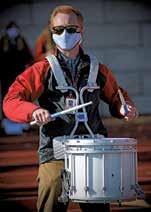
Heidenreich has also worked a variety of jobs to help pay for her tuition. Throughout college, she has held jobs in food service and retail, and has done research projects and internships through UW-Superior.

Heidenreich recently learned that she was accepted into law school at the University of Wisconsin-Madison, the city where her parents currently live. Once she and her cat, Princess Mittens, make the move from their off-campus rental home to Madison later this year, she will live with her parents for the first time since she was 12. The entire family looks forward to the reunion.
Madison is a special place for the Heidenreich family.
“My dad also went to college at Madison, and I grew up watching Badger games,” she said.

Heidenreich has ambitious plans to start her career as an attorney and eventually become a judge.
When she isn’t busy with school and civic duties, Heidenreich enjoys outdoor activities.
“I love skating and also hiking, particularly at state parks. I just like being outside,” she said.
“I also like to water ski,” she added. “My family has a cabin on the Mississippi River where I like to ski and ride in the pontoon boat.” Heidenreich also enjoys reading.
Looking back at her first 21 years, Heidenreich has learned to accept every opportunity life has to offer.

“If someone has an opportunity for you, say yes to everything you can: jobs, internships and research opportunities,” she said. “It’s also important to form good relationships with everyone —- from your instructors to other professionals.”
But if there’s one thing she is working on, it’s to become a bit less competitive, and a bit more collaborative.
“I just took an emotional intelligence class, and it really opened my eyes to a lot of things,” she said. “I’ve always seen a lot of things as a competition. I’ve maintained a 4.0 GPA throughout high school and college. Going forward, I want to focus more on working with everyone. Not everything has to be a competition. I want to be more collaborative and empathetic.” D
When abad si tuation develops fr om good intentions .›› Sa ra hHel wi g››Jos ephM ih alek ›› Da vidO be rs ta r››T homa sWit t
“What, exactly, is a trust? And why would I need or want to have a trust?”
I am frequently asked these questions in my role as an attorney working as a trust officer for a corporate trustee. Let’s demystify trusts this month!
A trust is a legal entity, created by an agreement, to own financial assets and property, manage those holdings, and distribute funds, all in accordance with the wishes of the person who establishes the trust. That person is known as the “grantor” or “settlor.” Other parties to a trust include the trustee and the beneficiary(ies). The trustee manages the trust assets and administers the trust. The trustee has the legal duty to always act in a fiduciary manner, or in the best interests of the beneficiaries. The beneficiary is the person who may receive distributions from the trust.
It is interesting to note that one person — you! — may serve in all three roles. Often, the grantor serves as his/ her own trustee, and the trust assets are used for the grantor’s own benefit. The trust agreement designates a successor trustee — which may be another person or an institution such as a bank — to step in should the grantor become incapacitated and/or following the grantor’s death.
A myth exists that trusts are only for the very wealthy. In fact, many people may find that a trust offers flexibility, security and efficiency in managing their financial matters. Trusts may be used to handle financial issues during a period of incapacity, to streamline the process of administering your estate following your death, to guide the expenditure of funds on behalf of minor children or by young adult children, to improve the quality of life for a person with a disability, to maximize the impact of charitable donations, and to minimize certain taxes.
A trust provides a way to manage funds and pay for the care of minor children in the event that both parents should pass away. In establishing the trust, the parents determine and set forth how they would like the funds they leave behind to be spent by the person(s) who will be responsible for caring for the children. Typical provisions include authorizing spending on medical needs and educational expenses. Additionally, the trust may provide more customized terms that reflect the family values. For example, the trust may provide that funds may be spent to send the child to a music, sports, or other type of camp one time per year. By giving such specific guidance, the trustee knows exactly how the parents would like the money to be distributed, and the guardian can feel comfortable spending the funds accordingly.
Sometimes parents are concerned about how their adult children would
manage the receipt of a large sum of money following the death of the parents. Trust language can provide a timeline for distribution of the funds. For example, a trust could direct that a certain percentage of the assets be distributed when a child reaches age 25, another percentage at age 30 and a final distribution at age 35. In this way, the young adult can learn to manage finances, while the remainder of the assets remain under the protection of the trustee.
A person with a disability may qualify for certain public benefits such as Medical Assistance. While benefits may cover basic necessities and living expenses, they often do not stretch to allow for entertainment or travel. Family members may wish to provide funds to allow the person to enjoy these “extras.” However, giving money outright to a person may be problematic with respect to eligibility for benefits. Again, a trust can provide a solution. Minnesota recognizes both “special needs” and “supplemental” trusts. These trusts provide funds for certain extra things and activities, without jeopardizing a person’s benefits.
Many of us want to maximize the impact of gifts we make to charity and minimize any taxes that we pay. As a person’s wealth increases, there are strategies available, using trusts, to accomplish both of these goals. D

Life during a pandemic can be…interesting, difficult, trying and exhausting, all at the same time. You’ve managed to juggle working from home, grocery shopping with your mask on, and helping the kids through online learning. It’s been a long year. Well guess what? You deserve a break and a treat. Take some time for yourself and indulge in one of life’s greatest treats — chocolate. Here are my five favorite spots to hit up in the Northland for what I like to call, A Chocolate Celebration. Most of the stores offer online shopping, curbside pick-up, and delivery, so you can be sure to receive your treat in the way you are most comfortable, but make sure to visit their online site first to see their current protocols.
Sweeden Sweets
Sweeden Sweets, located on Tower Avenue in Superior, is a hub of specialty candies, including a wide variety of chocolate treats. They boast chocolate covered cherries, cashew truffles, and my personal favorite, the chocolate covered potato chips — sweet and salty at its finest. For the more adventurous type, I dare you to investigate the chocolate-covered bacon or bacon s’mores. www. sweedensweets.com
Rustic Inn Café
Are you a pie enthusiast? Head up the north shore to the Rustic Inn Café and take delight in their five-layer chocolate pie, which includes layers of chocolate, meringue, cream and a touch of cinnamon. It’s so sweet, this little treat is a great one to share. www. rusticinn.cafe

Another option, order the pie through the Whole Foods Coop and pick it up there! www.wholefoods.coop
Great! Lakes Candy Kitchen

I know, I know, the Candy Kitchen in Knife River is not open the entire winter and you may just have to wait to stop in for one of their sweet treats, but come spring, the wait will be worth it.

This little gem includes third- and fourth-generation candy makers and, following their family recipes, you can watch them hand stir ingredients in copper kettles. Plus, it just gives you one more thing to look forward to after our long winter! So mark it in your calendar and visit them come early May, the fudge will be waiting and you will not be disappointed. www. greatlakescandy.com
Located in DeWitt Seitz in Canal Park, Hepzibah’s aroma will drive you in. They exhibit everything from locally made fudge to award winning truffles. And their chocolate ore boats are adorable and make for a fun little Duluth gift. When you are out and about in Canal Park, be sure to stop by! www.chocolatesduluth.com

Rocky Mountain Chocolate Factory
Do you like apples? How about caramel apples? If so, this is the place to visit. From English toffee to rocky road, they have a wide variety of chocolate-dipped caramel apples to choose from. Not into apples? Check out their chocolate sea salts, another tasty treat for the buds or try my personal favorite, the chocolate-covered strawberry. With two convenient locations, one in Canal Park, the other in the Miller Hill Mall, it’s the perfect little drop-in. www.facebook.com/rmcfduluthmn
However you are managing life during this pandemic, take some time and indulge yourself. And while you’re at it, share the love with someone you know that might need a pick me up, send A Chocolate Celebration to a friend. With the variety of delicious chocolate in the Northland, I’m sure you can find the perfect gift. D

“Gettinga colonoscopy isn’t exactly fun, but colon cancer is way worse,” said colon cancer survivor Brenda Russom. After watching her mother endure a long battle with colorectal cancer, she had every intention to start getting these exams once she turned 50, following the American Cancer Society’s recommendation. However, her fight against this cancer started a bit sooner than expected.
“When I was 48, I went to the Emergency Department because I was bleeding,” explained Brenda. “They scheduled me for an emergency colonoscopy the next day, and ended up finding stage three colon cancer. I was shocked.”
Fortunately, she also found out that there was a surgery that could save her life.
Her doctors were able to remove all the cancerous tissue, and she was put on a schedule of frequent colonoscopies.
“I had two colonoscopies that first year,” said Brenda. “When they were both clear, they had me come in once a year for two years. After those, everything still looked good. I was able to take a break for two years.”
Brenda recently came in for her fifth colonoscopy and found out that she is still completely cancer free. After her
experience, she has never been more passionate about convincing others to get their colonoscopies.
“I talked all of my siblings into getting screened. I even convinced 12 of my friends to go in!” said Brenda. Find it, fight it and live
Colorectal cancer is the secondleading cause of cancer-related deaths in the United States. However, it’s also a very slow-growing cancer. That means when it’s found in the early stages, it’s very treatable.
The best way to find this cancer early is through regular screening.
“One of the best ways to screen for colorectal cancer in people without symptoms is either through regular colonoscopy or fecal-based testing,” explained St. Luke’s Gastroenterologist Dr. Stephanie Judd Irwin.

In general, Dr. Judd Irwin has found that many are committed to regular screenings. However, some are more reluctant. Fear of complications, uncertainty over what a colonoscopy entails or unwillingness to take a bowelcleansing preparation can all hold people back.
“It’s always best to push past these fears,” she said. “Studies are clear and convincing that earlier detection of cancer results in better outcomes.”
Everything starts by preparing the colon. Patients adhere to a clear liquid diet the day before the procedure. Then, they drink an electrolyte solution which causes their colon to empty.
“Anything that’s a clear liquid can and should be consumed to help flush the contents of the colon,” explained Dr. Judd Irwin. “That includes things like broth without meat or vegetables, lemon-lime or ginger soda, Jell-O and popsicles.”
On the day of the procedure, patients can expect to be at the hospital or other outpatient setting for about two hours. During the colonoscopy, the colon and rectum are inspected by a long tube that contains a light and a camera. Most patients choose to be sedated for this procedure. However, the gastroenterologists at St. Luke’s can perform the procedure without sedation.
“If a patient chooses to forgo sedation, we use what’s called water immersion technique instead of inflating the colon with carbon dioxide. This makes the procedure a lot more comfortable,” said Dr. Judd Irwin.
A typical exam lasts 15 to 20 minutes. Recovery time after the procedure is about 20 minutes.
“If patients aren’t sedated, it cuts out
How regular screenings could save your life
the recovery time,” explained Dr. Judd Irwin. “They also don’t need to have an escort drive them home.”

Due to a recent update, the American Cancer Society now recommends that colorectal cancer screenings begin at age 45 for those at an average risk level. As an alternative to colonoscopy, stool-based tests such as fecal immunochemical testing (FIT) or Cologuard are available. These tests can be collected at home and are for those who are at an average risk level. If individuals don’t know what risk level they are, they can talk to their primary care provider or ask for a referral to see a gastroenterologist.
As for where to schedule your colonoscopy, Brenda recommends St. Luke’s.






“My experiences at St. Luke’s have been great,” she said. “They talked me through everything and made me feel very comfortable.”

Dr. Judd Irwin says the goal is to make the entire process as seamless as possible.
“Each patient deserves the very best, and exceptional care is our standard,” she said.
Learn more at slhduluth.com/gastroenterology. D


Samantha Roffers, a Moose Lake writer, believes it’s important to shop for things you love and feel comfortable in. Everyone’s style is unique and that’s what makes it so special.
 By Samantha Roffers
By Samantha Roffers

Hellodear readers, welcome back! If this is your first time reading The Woman Today, we are so happy to have you! This month it’s all about effortlessly spicing up an outfit with accessories.
Accessories such as scarves, jewelry, caps and hats are all a great way to change up a look and make it unique with minimal effort. Personally, I’m someone who loves bold prints, bright colors and big jewelry. But as always, fashion and makeup is all about what makes YOU happy and comfortable, there really is no right or wrong in my book.

I reached out to Colie Karnis, owner of The Diamond T Cowgirl in Sandstone, to shop her inventory for this issue. She is a Minnesotan small business owner, mother, bucking bull raiser and all around kick-butt woman. She had such a great selection of hats, shirts, earrings, necklaces, bracelets and so much more! She definitely carries something for everyone. Alright, let’s get to the good stuff... D
by SamFor all of these looks I started with a basic black shirt and my turquoise pendant which I never take off. To start off, I simply added a pair of dusty rose statement earrings. This immediately adds a pop of color and brings out complementing tones in my hair and face. I love how these earrings are lightweight while still making a big statement, and the soft fringe isn’t irritating if it brushes my face or neck.
For this next look I added a silk wild rag that complimented the dusty rose earrings. It’s not always about matching colors, but rather using complimentary colors and tones. Wild rags are one of my favorite ways to accessorize an outfit. They are soft, warm and lightweight, you can basically wear them anywhere. You can easily make wild rags look dressy or casual depending on how you tie them.
3Adding onto the dusty rose earrings and floral wild rag, I put on my pink and grey Stormy Kromer cap. This cap is adorable, comfortable and so warm! This is a great setup for basically any outing, whether it’s shopping, running errands or any outdoor activity. You can easily add or remove things to cool off or warm back up and both the kromer and wild rag store nicely in a bag.

Now this look is probably my favorite and, again, so simple! I absolutely adore these turquoise and red earrings paired with a turquoise hair tie concho. I pulled my hair into a low side pony, added the earrings and a complimentary scarf and got this great look! This would look so great with red lipstick as well. With only four simple additions, what a difference from the first look!
5
I pulled out an old faithful for this look — this red scarf is a staple of mine. I don’t own much red, so when I’m looking to brighten up an outfit it’s usually the item I reach for. It pairs well with these gorgeous white concho fringe earrings and black top. If your ears aren’t pierced or earrings just aren’t your thing, a silver hair tie is another great way to add some shine and keep your hair out of the way!
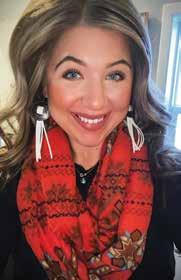

This one’s for my neutral people. Even though an oatmealcolored scarf and hat might not be super exciting on their own, when paired together they make a perfectly cozy addition to your winter outfit. The great thing about a neutral accessory is that it’s going to pair really well with many different tops and coats. This look is simple, timeless, warm and comfortable.
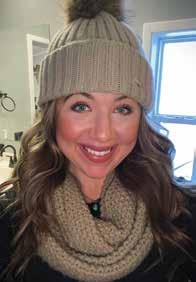
6

Convenientmorning and evening hours
Doctor-owned,locallyloved

We have threelocations in your area:

We all want the best for our children. Most parents gladly invest a significant chunk of their income on things like nutritious food and warm clothing for their little ones, even occasionally splurging on a new game or toy.
But another vital aspect to your child’s development is their daily care. There are many important facets to quality child care, including interactions between staff and children; welleducated employees; a focus on learning; and even healthy meals. With so much to think about, where does a new parent start?
We recently visited with Stacy Pohjola, director and owner of Laugh & Learn Childcare Center, with two locations in Cloquet and Hermantown. Pohjola said she knows what parents should look for when it comes to quality care for their children. She is also wellversed in several useful resources, where parents can go to “do their homework.”
Pohjola herself has a bachelor’s degree in elementary education, with a minor in early childhood education. Prior to opening her business, she taught 4-year-old kindergarten in Superior, and worked as the director of two child care centers. She also has three children of her own.
An important aspect of any child care center is an educated staff, Pohjola explained. At a minimum, employees should have a baseline knowledge on issues related to children’s growth and development. Laugh & Learn accepts children from 6 weeks old to age 12, a large span requiring a wide range of knowledge and experience.
“We have 14 employees in Hermantown and 14 in Cloquet,” Pohjola said. “All of our staff have different roles. Each classroom has its own lead teacher. There are also assistant teachers and aides. Each site also has an assistant director. These roles depend on the employee’s education level.”
Laugh & Learn Child care Center considers itself a school.
Stacy Pohjola, director and owner of Laugh & Learn Childcare Centers in Hermantown and Cloquet, encourages new parents to visit potential child care facilities to ““see staff interacting with the children, kids having fun, and they should just get a good feeling about the place.”


As such, the staff create daily schedules, lesson plans, individual assessments, early childhood screenings and all of the lead teachers have completed a minimum of 50 hours of training on a variety of topics.
Laugh & Learn prides itself on encouraging the children’s imaginations, and keeps the use of technology, such as television and tablets, to a minimum. Here, the children enjoy outdoor play time, art, reading and music. They also learn subjects such as math and science. Parents should avoid facilities that plunk children down in front of devices for hours at a time.
Laugh & Learn is also a participant in the voluntary Parent Aware program, and maintains a four-star rating. To maintain this accreditation, the facility goes above and beyond the basic standards of child care. More information, along with a comprehensive list of Parent Aware-qualified facilities, can be found at parentaware.org.
Maintaining a safe, healthy environment for children is a top priority for a quality child care facility. This includes quality food, tracking the children’s health and wellness, and stringent sanitation procedures, particularly during the COVID-19 pandemic.
For instance, Laugh & Learn utilizes an app called Brightwheel. This handy tool offers much for the busy parent.
“We use Brightwheel to send pictures, videos and messages,” Pohjola said. “And for the younger kids, we log what they ate, how much they ate, and even their potty breaks and nap
schedules.”
Laugh & Learn’s meals are catered daily by Chickadee Catering, ensuring a healthy breakfast, lunch and afternoon snacks for the children.
During the pandemic, Laugh & Learn has increased their cleaning, sanitizing and hand-washing protocols for children and staff. Additionally, they currently aren’t allowing parents and caregivers inside the building for drop-offs and pickups. While this choice was voluntary, it was difficult.
“That was a really hard decision for me to make, but I was worried about the COVID exposure rates,” Pohjola said.
Taking this extra step has required additional staffing to unpack the kids at the start of the day, and help prepare them to go home. But for Pohjola, it was worth the investment. Laugh & Learn staff also conduct daily visual checks of each child, along with a quick conversation, to make sure everyone is healthy and well.
But the ultimate health of the facility’s population rests on parents’ shoulders.
“We ask parents to screen their kids at home, and keep them home when they are sick,” Pohjola said.
Another unique service related to COVID-19 is that Laugh & Learn will help school-aged children with distance learning. Their hours of operation are 6 a.m. to 6 p.m. Monday through Friday. They remain open on snow days, too.

Pohjola offered several concise tips for helping a new parent begin the process of selecting a child care facility. The first is to simply visit.



“Parents will want to take a tour,” she said. “They should see staff interacting with the children, kids having fun, and they should just get a good feeling about the place.”
Pohjola recommends a few websites for locating a quality child care facility, including Parent Aware, Childcare Aware, and a Facebook group called Childcare Providers and Resources of the Northland. The latter is a resource for both parents and providers, where they can share knowledge and information. Pohjola stated that word-of-mouth, such as asking friends, relatives and colleagues for advice on a quality facility, also never hurts.
Even if a parent does all of his or her research, and ultimately locates a great placement for their child, a few tears on day one are normal; perhaps even expected.
“Some of the kids cry on their first day,” Pohjola said. “I tell parents not to hang around. If you’re nervous, they can sense it. Just go ahead and leave, and we’ll make sure your child is having a great time — usually within about an hour.” D Andrea Busche is a Duluth freelance writer.

Historically, there has been a stigma around homeschooling: children might not receive quality education at home or develop proper social skills. With COVID-19, education as we’ve known it has had to change. In most cases, children have engaged in a spectrum of learning from home. This has had many challenges.
With parents also working from home and new distractions for kids, concerns rise about whether children will suffer. Many parents are asking, is homeschooling a sufficient alternative to the traditional school setting?

Is it possible to wait it out with distance learning and do the best we can until schools reopen? Parents in the Northland have been working hard to provide the best education possible for their children.
Samantha Kelleher, 32, of Lake Nebagamon, Wisconsin, grew up homeschooled by her mom in Duluth. Kelleher said her mom “took on homeschooling without even having her high school diploma.” She taught her children that it’s OK to not know the answer right away and would invite them to learn alongside her. Time passes quickly, making learning together a real gift for both parents and children.
Kelleher enjoys childhood memories of doing schoolwork and getting to play with neighbor friends, without having to be away from family at school for
several hours each day. She wants to give this experience to her children. An advocate for homeschooling, Kelleher is even more an advocate for parents to confidently make education decisions for their children, believing that each parent knows what is best for their family. Wanting her husband and her to be the biggest influences in their children’s lives, Kelleher considers it a privilege to be able to teach them.
Watching them grow and learning their strengths and weaknesses is not all easy, however. It can be frustrating watching them struggle and having to apologize to them later for being impatient. It’s all worth it though, Kelleher said, when she witnesses a learning moment.
“You get to see the sparkle in your child’s eye when they read — that’s huge,” she said.
For Angela Piket, 41, of Proctor, it was not an easy decision to homeschool. In the beginning of the lockdown, the school district impressed her with their distribution of supplies via school buses stopping at each student’s house. When it became clear that distance learning was here to stay, Piket began searching for a homeschooling curriculum. One major criteria was limiting screen time. With distance learning, suddenly, “they were bears from all that sitting and looking at a screen,” she said. Used to less than one to two hours per week, having so many video
calls, both parents and kids were overwhelmed.
What Piket learned from other homeschooling parents was invaluable as she started teaching her children. She began doubting herself, however, wondering if she must be doing it wrong because her house and everyone in it weren’t all perfect. Piket said that once she realized “it does not need to look like traditional school in your house,” she relaxed and she encourages other homeschooling families to embrace this freedom, too.
“The reality is,” Piket said, “I have a moody 9-year-old and an out-of-control 6-year-old (and) two dogs who are often barking and howling along with everyone else and it’s complete chaos.”
And this is OK.
Her first grade son would ”much rather be hammering things into the ground” than learning to read. Her third grade daughter, already an overachiever, is more an artist than her parents. Rather than pushing them into the depths of science and math she enjoys, Piket wants her kids to learn everything they can in each subject, but prioritize their interests. Piket’s also grown in compassion toward them when they struggle.
“We slowed math way down (for our daughter) and she’s been much more willing to try to do the math now,” Piket

•
said of the flexibility of homeschooling.
It’s likely her son will return to in-person school postpandemic for more social interaction, while her introverted daughter will likely continue with homeschool. Thinking about the future of education, Piket said she hopes that schools will have “more flexibility in letting kids learn the way they need to learn.”
Homeschooling continued on page 29
•


The College of St.Scholastica is equipping careprofessionals through CSWE-accredited, values-based undergraduate and graduate social work programs.
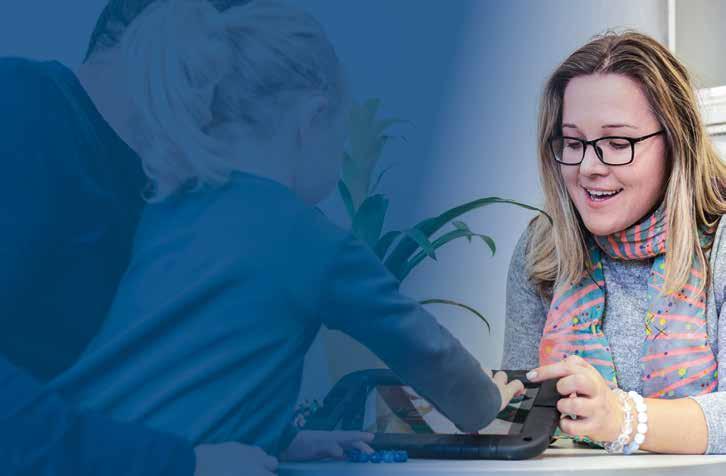
•A flexible, hybrid learning environmentwith twotracks forthose with and without aBAinSocialWork
BA in Social Work
•Values-based curriculum including interprofessional education and 570hours of in-field service
•Social work healthcarecertificate option




For Stephanie Malpass, all was smooth sailing in September 2018. That’s when she married her boyfriend of 10 years, Todd Malpass, on the shores of Lake Superior, celebrating with family and friends on Barker’s Island.
A ripple in the water surfaced a month later. Stephanie first felt a lump in her left breast in mid-October. She gave herself time to process and prepare for the expected diagnosis. On Nov. 8, she had a mammogram and ultrasound. Breast cancer was confirmed.
“It was a very aggressive and fast-growing cancer, which knocks you back a little bit,” Todd said.
Stephanie, whose optimism is infectious, was devastated.
“I thought about my kids, my grandkids, my husband, my parents. I was sad because I thought about what-if — what if I’m not there for them. I worried about everyone,” said the 55-year-old mother of three. Todd has three children from a previous marriage, as well. “You don’t want to be a burden and have people take care of you.”
Initially stunned, the Superior couple found comfort in their conversations with Dr. Dan Nikcevich, an Essentia Health oncologist. Stephanie and Todd described Dr. Nikcevich as patient, compassionate and genuine. “He cared,” she said. Dr. Nikcevich never was too busy to answer their questions. He was simultaneously their doctor and counselor. After telling Stephanie she had cancer, he then called it “treatable cancer.”
The word “treatable” was music to their ears. Stephanie and Todd also found strength in the plan Dr. Nikcevich mapped out for them. They now knew what to expect and had a road map to follow.
Stephanie started chemotherapy in December 2018 and, upon completing it in May, had a double mastectomy. Dr. Nikcevich then delivered the news they’d been hoping and praying for.
“You’re cancer-free,” he told them.
As a precaution, Dr. Nikcevich prescribed more chemotherapy to remove any remaining traces of cancer — scant as they may have been. This subsequent treatment significantly reduced the chance of recurrence.
Stephanie had breast-reconstruction surgery in December 2019. She’s been in remission since.
Throughout that trying year, Stephanie and Todd clung to the positives. While it would have been “really easy to just sit on the couch,” she was adamant about maintaining a “normal lifestyle.” That included continuing to work as an administrative assistant at Enbridge.

“Stephanie is full of strength and resilience, and her intestinal
Not long after Stephanie and Todd Malpass married in September 2018, she was diagnosed with an aggressive and fast-moving breast cancer. Stephanie endured surgeries and a year of chemotherapy treatment. She’s been in remission since December 2019.
fortitude propelled her forward,” Dr. Nikcevich said.
A sense of humor also aided her recovery.
“Cancer has saved us a ton of money. We didn’t have to buy things like shampoo,” Todd joked.
More than anything, though, it was the love, support and selflessness of others that carried Stephanie and Todd. Her sister would drive from Hudson, Wis., to accompany Stephanie during chemo treatments. Others were there for chemo, as well. Todd’s sister, a registered nurse who lives in Sault Ste. Marie, Ontario, came to help for 10 days after surgery. Kids and grandkids helped shave her head, and a couple family members then shed their own locks as a sign of solidarity.
People checked in with phone calls and text messages. They delivered healthy, home-cooked meals. They stopped by to clean. There was a well-planned and well-attended benefit. A boss had bracelets made that read “Stephanie Strong.”
Todd, Stephanie says, was her “rock.” Similarly, her daughter was always there for Stephanie and Todd.
“The uncomfortable feelings of fear, worry and powerlessness that I felt at the beginning stages of diagnosis, chemotherapy and breast reconstruction were softened and relieved by the love, optimism, hopefulness and appreciation for my life and those who I love and who love me,” Stephanie wrote.
Half a year before her diagnosis, in February 2018, Stephanie had a clear mammogram. The ensuing fall, her life was “turned upside-down.” That’s why she highlights the importance of women conducting self-exams and listening to their bodies. If something doesn’t feel quite right, consult your primary care provider. Better to be safe than sorry.
Stephanie is grateful she caught her cancer early enough for it to be treated. And she heaped praise on her Essentia care team, which helped her navigate a scary and uncertain time. That included her
Homeschooling continued from page 27
Lyila Stroup, 44, of Superior, an elementary school special education assistant, urges parents to do whatever it takes to get their children to virtual meetings.

“If you just get your kid logged in, get your kid there, set them up,” she said, “I will keep them engaged and they will learn something. But they just have to show up.”
Sadly, for many of the sessions available, very few children, if any, attend.
Not what she hoped for, as a special education assistant or parent, Stroup has tried to make the most of distance learning, having her children buddy up with classmates to work together. She knows how difficult it is to work and parent and educate from home.
“And here I am, I’m trying to monitor and I’m like, ‘Oh, yeah, send your kid over, I’ll be responsible for making sure everybody’s doing their stuff,’ and then I find out they’re not doing anything and we’re sitting in the same room together.”
Commending her colleagues and her children’s teachers for how virtual teaching has improved, she worries about widening gaps in education and
Malpass continued from page 28
own primary care provider, Olga TerGrigoryan, who didn’t mince words and encouraged Stephanie to schedule a mammogram; as well as Dr. Nikcevich and his attentive colleagues at Essentia’s cancer center; and her plastic surgeon, Dr. Jason Fowler, who was methodical and supportive.
Today, Stephanie feels great. And she’s back to spending money on things like shampoo and other hair-care products. Neither she nor Todd mind the expenses.
“No problem with it at all,” Todd laughed. “We’re glad to pay those bills.” D Louie St. George III is the public relations/ external communications manager at Essentia Health.
social-emotional development. Stroup worries even more for the children without siblings, having less social interaction, while parents work from home. Because of the in-classroom support she and her colleagues provide, Stroup believes if her students and her own children were there, they’d be learning better.
“For this to be the new norm, I see my kids suffering greatly,” she said. D
• Environmental Education integrated throughout the curriculum
• Art, Music, PE, and Environmental Ed Specialists

• Small Class Sizes
• Busing from Duluth and Two Harbors



Motherhood brings about hopes and dreams both for Mom and her baby and how she will parent. It’s also full of fears. The normal anxiety that comes along with being a mom of a newborn has been amplified when paired with the global pandemic. Staying flexible, connected relationally and staying positive have been crucial for mother’s and baby’s wellbeing. In a time when there has been so much grief, newborns have been a gift and picture of hope to celebrate with new parents.
Temper expectations
Erin Considine, 32, speech language pathologist at Essentia Health, is a mother of two girls, Clara and Lucy, and still has the “giddy newborn, new-mom feel.” With a toddler born pre-pandemic and a newborn in fall 2020, she is grateful for what she’s been able to do at home with both girls through this early season of motherhood.
On the same day that news broke of COVID-19 hitting the U.S., Considine found out she was pregnant. When her husband, Clint, came home, asking how her day was, she said: “Well, I’m freaking out a little bit.” He said, he was freaking out, too, like everyone else, but, Considine said, “‘No! There’s more.”
Considine has loved watching her
girls growing up as sisters. As a family, they have enjoyed lots of walks, reading books and lots of baking, too, courtesy of her husband.
Considine encourages new moms to acknowledge that sometimes there are bad days, but to focus on what they can do, instead of what they are missing. She believes it’s important to remember that “it’s more the mom that’s missing out than the baby.” She also encourages her mom friends to spend time allowing themselves to feel the sadness of expectations not going to plan and to reach out for support when they need it without feeling guilty.
Being a new mom can be isolating already, so being proactive to arrange regular digital, or in-person when appropriate, visits is crucial.
For her firstborn, Considine and her husband eagerly allowed anyone to visit at the hospital, thankful so many people wanted to meet the baby. She also remembers being overwhelmed, feeling crowded and hot, learning to breastfeed. Then, the pandemic set the boundaries, and “in a lot of ways it’s been nice,” she said. Although it was disappointing to not be able to have her husband at the initial ultrasound appointments, she says it was “a beautiful hospital visit” with Mom, Dad and baby No. 2, having a quiet and peaceful delivery without
the happy commotion of visitors.
The doctors’ standard advice given to protect new babies is society’s new normal: Wash your hands and avoid large crowds.
“Clint and I took Clara everywhere when she was born. I mean, we were at church when she was 5 days old. We would bring her shopping. I went and stayed in the Cities for a week and a half before she was even a month. And now, I’ve left my house, I think, three times (in the first six weeks) since Lucy was born.” Letting go of her once tightly held expectations has meant enjoying the start to both of her daughters’ lives. Support and shared experiences
Kindergarten teacher, Jill Ellison, 29, says her newborn daughter, Tova, “is just so cool.” Ellison wants to be a cheerleader for every mom she meets because COVID-19 has been hard. All the normal fears and anxieties of being a mom are hard. Doing them both together is even harder.
Ellison’s positive outlook on life and her faith have helped her during pregnancy and postpartum since so much of what she imagined for this time was not what happened. Allowing herself to talk about and feel the depths of sadness has decreased the overwhelm.

Hospital protocols matching her own desires relieved a lot of social pressure of

disappointing people. For Ellison and her husband, Scott, being together in the hospital only with their newborn and the hospital staff, felt sacred in a world that has felt dangerous.
Surprised by how much fear and anxiety she experienced leading up to giving birth and afterward, she said: “I really wanted to feel connected to other moms and I wanted to have my fear lessened knowing that I was in a group of people going through the same thing. I’ve never felt anxiety in that way where my entire body is buzzing and I couldn’t sleep.”
Normal postpartum anxiety caused by changing hormones is one thing, but added with anxiety about whether the coronavirus will ever end weighs heavily on many parents’ minds.
Ellison and her husband met with a marriage counselor before their baby was born. This was beneficial, helping them understand the importance of having their friends involved in a plan to alleviate stress. They arranged with a couple close friends who could be oncall for any help they might need mentally, physically, emotionally or spiritually. She recommends all new moms talk to their partner and a counselor, if possible, to make a plan to stay well and to not be isolated, especially during pregnancy and the first part of their newborn’s life.
Dr. Margaret Perko, Essentia family medicine physician, gives five top tips for new moms:

1. Be flexible. Protocols about COVID-19 change continually in the hospital and in society. Not only does caring for a newborn require adaptation to many new scenarios, but the coronavirus adds even more to adapt to.
2. Be protective. Don’t feel guilty about protecting the health and wellbeing of your newborn. You have permission to be Mama Bear.
3. Assert boundaries. You are the
parent, so you get to decide what is and what is not appropriate for your newborn to encounter. This is something that only you and your partner can decide.

4. Reach out. If you need help, get in touch with someone. Being a new mom can be isolating, so let a friend or family member know how you are doing.
5. Get support. Many in-person groups have not been able to meet, but medical professionals still want to help. Call your doctor or clinic for advice. D
It is about that time of year where everyone begins to feel cooped up and restless, ready for spring though wintery weather drags on. Couple that with an entire year of canceled events and social distancing, and anyone is bound to come down with a case of cabin fever.
Fortunately, there are myriad local opportunities for learning new things, creating new connections and breaking out of the boredom rut.
“Winter can be difficult even in the best of times,” said Angel Dobrow, co-owner of the Zenith Bookstore in Duluth.


Dobrow is the facilitator of Zenith Bookstore’s book club, which she believes is a perfect winter activity in Duluth. Since the group switched to a virtual format at the beginning of the pandemic, one can now attend without even needing to shovel the driveway.
The book club meets the first Tuesday of the month from 6-7 p.m., reading one book monthly. Rather than having a theme, the group reads books covering a variety of topics and genres.
“I have had members of the book club say, ‘I never would have picked this book up had it not been on the book club list,’” Dobrow said.
The group at Zenith has folks who come and go, with a core membership of about a dozen people. Prior to the pandemic, they would meet at the bookstore, but they now facilitate their meetings on Zoom.
Dobrow has been in some iteration of a book club for roughly 18 years —
larger ones like the one at Zenith, small ones consisting of just her and a friend, clubs with specific themes, even groups where people simply talk about what they are reading as individuals.
“It’s a great way to share ideas,” she said, “to share parts of yourself.”
One benefit of book clubs is that they are self selective, so they tend to bring together like-minded people, Dobrow said. Even so, every book will elicit a different response and interpretation from each reader, which is what makes reading together fun.
“Everybody is reading the same book, but there will be 10 to 12 different interpretations, and all of them get thrown out in the middle of the room. We share, but we also hash things out. We tie books to current events, including current personal events. It really is just a great place for sharing.”
Zenith Bookstore currently has their 2021 book club books through June listed on their website to give folks time to find a copy or go to the library. Book club books purchased at Zenith receive a 15% discount.
To get involved, email books@ zenithbookstore.com and you will be sent a Zoom link for the next book club meeting.
Dobrow recommends everyone join a book club, even if it is not Zenith’s specifically.
“All you need is a book and four or five people who are willing to read it and have a discussion,” she said.
Dobrow is also happy to give pointers and recommendations to those who want to start their own club. She can be reached at the email above.

For those who are eager to learn but perhaps have a shorter attention span than a book club requires, the University of Wisconsin-Superior’s Center for Continuing Education launched a program called “Coffee Break Courses.”
These 10- to 15-minute courses cover a variety of subjects, from brewing to the modern sonnet to creative ways to connect on Zoom.
“Our main goal with these was to be able to continue to provide short learning experiences for the community, as well as be able to provide accessible programming to our community during this pandemic,” said Danielle Fagan, outreach program manager at UW-Superior.
Over 480 people have registered for the Coffee Break Courses since their launch in May 2020. The courses are hosted by “locally sourced professionals” including UW-Superior staff and faculty as well as community members.

Courses resume in April and will cover a variety of new topics. Register at uwsuper.edu/cce. Registrants will be emailed a link to a YouTube playlist where they can tune in to new courses and view older ones for a limited time.
“We’re hopeful that these bring valuable experiences for people that can support them in their personal and professional growth during this time,” Fagan said. “The feedback that we’ve received is that they’ve definitely been successful in that.” D
Wh en yo ur joi nt sw ear out and need re pl ac em en t, co nsider an inno va tiv e appr oach. Lak ew alk Su rg ery Ce nt er no w of fe rs join tr eplac emen tu ti lizing Ma ko Sm artr obo tics ™t echnolo gy– enabling yo u to ha ve am or ep er sonaliz ed and pr ecise sur gical ex perienc e. Ta lk to yo ur su rg eon to see if Ma ko is the righ to pt ion fo ry ou.

In times of crisis, human beings often turn to art. Whether it be music, novels or television, this sharing of stories and experiences helps people feel more connected, even while social distancing.

Poetry in particular forces the reader to pause to focus on the words, their rhythm and meaning.
“Poetry can help quiet the mind and give people a little respite, a little time for reflection,” writer and poet Sheila Packa said.
Packa served as Duluth’s poet laureate from 2012 to 2014 and has published several books of poetry. She takes great joy in teaching writing courses and facilitating writing workshops. As poet laureate, Packa facilitated 40 workshops across the region at women’s shelters, family justice centers, the Northeast Regional Corrections Center, schools, and girls’ groups.
Writing can provide solace and healing during times of crisis and
change. In fact, the American Psychological Association reported that writing can reduce stress and strengthen the immune system. Studies have shown that writing can even help wounds heal more quickly.
“If you use your voice and share that with other people, it really does help
people get through changes,” Packa said.
Change and migration is a recurring theme in Packa’s poetry, and much has changed for her since the start of the pandemic. While she is grateful for the extra time at her writing desk, she — like many others — is missing her social connections and old routines.
“For 100 years, we haven’t had a pandemic in this country and now we do,” Packa said. “All of a sudden it’s changed everything. It’s changed what people are writing and how they’re writing.”
Because writing can be a rather solitary activity, even in the preCOVID-19 world, there are a number of formal and informal groups in the area to help writers connect and share ideas.
One of these organizations is Lake Superior Writers, whose goal is “to support writers in their artistic

development, provide opportunities for them to share their work, learn, improve their skills, and foster a sense of community among writers who live in our region,” according to board chair Leslie Mehle.
Lake Superior Writers is a volunteerled nonprofit with over 200 members. Their flagship event is their annual writing contest, and they hold various events throughout the year such as classes, poetry readings and panels.

Though initially worried about moving their programming online due to the pandemic, Lake Superior Writers has found that folks are still eager to participate in their events.

“I think people really miss the connection,” Mehle said. “We’ve really worked hard to find a way to keep connected with our members and the rest of the writing community.”
“Writer” is a broad term for Lake Superior Writers, as their membership is open to anyone who likes to write, whether they are published authors or simply keep a journal.


“It’s all legitimate,” Mehle said. “It all matters. We’re just here to meet people where they are and provide opportunities that will keep them improving and find their voice.”


In terms of creative process, Packa draws much of her inspiration from time spent outside; images from her walks or hikes will stick in her mind and urge her to find deeper meaning.
“Invariably, I will find some visual, object or image that stays with me, and I usually start by writing about that. I
Lake Superior Writers works to cultivate the literary community in the region. Since the start of the pandemic, they have moved their events online.
describe it and see where it goes. I try to develop it into a metaphor,” she said.
Packa describes poetry as a “language inside the language” focused on recreating an experience for the reader. They should see the treetops, feel the wind on their cheeks, hear the rush of the river.
Conveying this experience makes the metaphor more powerful and the meaning of the poem more profound, cementing an intangible idea in pen and ink.
“Whatever you write about makes it stronger,” Packa said. “If you write about justice, if you write about the environment, it makes it stronger. It brings it into the conversation. It makes people aware.”
Though writing can seem intimidating, the great poet Mary Oliver viewed the process of poetry as no different than the process of living a life: “Pay attention. / Be astonished. / Tell about it.”
More information on Lake Superior Writers and their upcoming events can be found at lakesuperiorwriters.org. To learn more about Sheila Packa’s work, go to sheilapacka.com.
A“model home” is built as a showplace of the craftsmanship of its designer/builder. The model home is available for viewing and/or touring, and those who see it can contract with the builder to incorporate elements from the home into their own build or remodel. Some people might even choose to have the home recreated “as is” on their plot of land or make an offer to purchase the model home at its location.

In Duluth’s Hartley Estates residential area is a model home built by Bruckelmyer Brothers. It’s a “small luxury home” with smart features and special touches that must be experienced firsthand in a visit to the home, said Nathan Rosenlund, director of sales and marketing of Bruckelmyer Brothers in Duluth.
“Bruckelmyer Brothers purchased the lot; our design team designed the home; and our builders built the home,” Rosenlund explained of the start-to-finish process that also included furnishing the home. “Our intention was to put the model home in the Parade of Homes this past year, but that event was canceled because of COVID-19. We use it as a model home so clients can meet us and see the work that we do.”
PHOTOS BY COMSTOCK CREATIVE, COURTESY OF BRUCKELMYER BROTHERS The model home built and decorated by Bruckelmyer Brothers allows clients to experience the craftsmanship the company has to offer, hands-on and in-person, such as the walnut hearth and shelves and maple wood floors throughout the first floor.So how does a builder/designer design a home when there is no homeowner in mind? Bruckelmyer Brothers followed the plan they always use.
“With any design build, the first thing you do is create a list of things you want in the home,” Rosenlund explained.
For this model home, they worked with the following list of features that make sense for many of today’s home builders:

• Build on slab-on-grade foundation to allow for energy-efficient radiant in-floor heating.




• Build on a smaller footprint, but still design for luxurious living and comfortable entertaining.
• Include three bedrooms (master and two additional bedrooms).
• Design an open-concept main floor. Include a partial attic, with a library, bedroom and bathroom located on this upper level.
Continued on page 38

Once they had their list of “must-have” elements, the design team began working on layout of the home. Building planners used virtual reality to walk through the home. An on-staff interior designer was brought into the project to coordinate modern color schemes of grays, whites, beiges and browns. Building was completed in June 2020.
This Bruckelmyer Brothers’ first model home project is meant to give customers a hands-on and in-person experience.
“When they come to the model home, clients get to see, touch and learn about what we can do,” Rosenlund said. “It’s not just seeing the home — it’s an experience that the client has. All the work that was put into the home was done so clients can experience our craftsmanship as they’re talking to us.”


The kitchen and large island, which are open to the living area, are flanked by the dining table (below) on one side and wide glass doors that lead out to the yard on the other. Peaking out around the corner are hardwood stairs with custom treads and carpet runner.
For example, Rosenlund said, when entering the garage, the individual can experience the epoxy floor: “What it looks like, how it curls up with the backsplash. You notice the dog wash and how you can wash your boots off there, but the water won’t go up the walls because of the backsplash. It goes down the drain.”

Visitors can also experience quality products used in making the home such as the maple wood floors in the kitchen, dining room, living room and in the bedrooms; the porcelain tile floors in












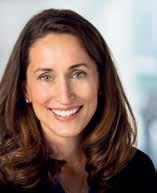








Proud
www.designheating.net
kevin@designheating.net
Askaboutrebatesfor


the three bathrooms; granite countertops in the kitchen and bathrooms; custom-made cabinets and walnut wood hearth and accents; and custom timbers used on the exterior of the home.

According to Rosenlund, many viewers are liking the layout of the 2,700-square-foot home. The size makes the home easy to care for, yet still allows for spacious entertaining in the open-concept main level that connects the kitchen, dining room and living room. Every square foot is utilized wisely with maximized storage space including numerous closets and cabinets.
Wide doorways and curbless showers are designed for owners who plan to stay in the home during their older years. Master suite and guest suite bedrooms are located on the main floor.


The gorgeous exterior of the home is stone, stucco and LP Shaker siding for a modern craftsman look.
People who tour the home can also experience the Alexacontrolled smart home system that turns on the heat and dishwasher, locks doors, dims and brightens lights, and












operates the home’s security system, garage doors and in-floor heating.
Hardwood stairs with custom treads and carpet runner lead to a loft with an entertainment center and library. Also upstairs is a bedroom and a bathroom. ‘We’ve never built the same home twice’
A model home is meant to give viewers ideas and inspiration for creating their own “dream home.” It’s a place to discover new products, current trends, and in this case, traditional craftsmanship of the designers/builders.

“Bruckelmyer Brothers has been in this a while,” Rosenlund said. “We can say we learned from our past clients. We’ve never built the same house twice, including this one. Everyone wants their home, and that’s the beauty of a design build. It brings your plan to life and your dream to reality.”
If you would like to make an appointment to tour the home, call Bruckelmyer Brothers at 218-525-2344. D Alison Stucke is a Duluth freelance writer.








 By Ali Carlson The Woman Today
By Ali Carlson The Woman Today
Before I began, I enlisted the help of my husband as he is the chainsaw master in our house. I showed him the finished product example from the DIY website momunleashed.com. He went outside and cut the pieces I needed.
Things I learned:
• Be specific in your instructions about how thick you want your wood pieces. You do not want them very thick as it will be harder to stand up and harder for the glue to hold.



• Make sure your pieces are cut as straight as can be. The glue will not hold very well with angled pieces of wood.
• Make sure you’re clear just how oblong you need the ear pieces to be. As you can see from my example, when they are not long enough, your project resembles a bear more than a bunny.
I did not have any black twist ties for the whiskers, so I improvised and used a black Sharpie and just drew on my whiskers and eyes.
This was a super easy and fun DIY project. Even though mine did not turn out as the initially intended bunny, I was very pleased with the bear! D
Supplies
6 slices of wood:
1 large circle for the body
1 medium circle for the head
2 small circles for the feet
2 oblong circles for the ears





Black twist ties or pipe cleaners for whiskers
Wood glue
Hot-glue gun
Link to tutorial:
Instructions
Let wood try overnight before you start to assemble.
Start by gluing the head to the body, overlapping a little, with wood glue.
Glue the small circles on the body, overlapping a little.
Take the oblong ear pieces and glue them behind the medium circle of the head so they stick out like bunny ears.

Hot-glue black twist ties for whiskers
https://momunleashed.com/2017/02/diy-rustic-wooden-bunny-step-step-tutorial.html




Nothing warms you up all the way to your toes better than a healthy batch of old-fashioned, made-from-scratch beef stew. This issue’s recipe feature is all about getting down to our roots and, perhaps, dig into a little heritage. Being quite a bit Irish myself, I reached out to my Aunt Erin to talk to her about my Grandma Blanche’s cooking and what Grandma made that was from the roots of our Irish heritage or inspired by our heritage. I recall Grandma making so many interesting dishes, one of which she was wellknown for: the giant batch of oatmeal she made each year on Christmas.
I must say, it really was delicious and still can’t be replicated to this day. However, there was another staple to the Keller household I didn’t know frequented the
By Megan Kellerhomemade beef stew. Aunt Erin sent me a picture of Grandma’s recipe card, and I just couldn’t wait to make this.


Blanche Keller was an exquisite woman — very fashionable; liked to have a lot of things; she also cared deeply for her family, always making sure they had what they needed. Her love for animals was a blessing to many, something I think I learned from her.
Anytime we went to Grandma’s house it was filled with delicious food and snacks — everything we couldn’t have on a regular day. I felt connected to her as I started to prep this meal. It was really fun to think how she may have made this herself, knowing my dad and his three sisters sat around the table and ate this very meal many times. I have made so many different dishes, it’s the ones from family that I feel are the most fun.
I prepared a simple rustic round bread recipe to accompany the stew. With four hours to wait, I went to the barn to work for a while. When I came back in, the house was filled with amazing aromas. I was taken back to my childhood at my Grandma’s, her house actually smelled like this often.
Once the stew was complete, I pulled it out of the oven while the bread was finishing. I did make a small batch of gravy to add to the stew as I think I may have used a bit too many veggies. Since this makes a healthy batch to feed four to five adults, we packaged up half the stew and bread, and dropped off dinner for the neighbors.
Making a meal and sharing it with people you care about is a great way to stay connected. I encourage you to find old recipes, try them out and have fun taking a foodie walk down memory lane. D



Recipe courtesy of onsuttonplace.com
Ingredients
3 cups white flour


1 3/4 teaspoon kosher salt

1 teaspoon active dry yeast





1 1/2 cups very hot water

1. In a large bowl put the hot water and yeast. Stir to mix and let set for 5 minutes.


2. Add flour one cup at a time along with the salt. Stir to combine. Dough will be shaggy and messy.
3. Cover with plastic wrap and let set for 12-18 hours. Do not refrigerate.


4. Preheat oven to 450 degrees and place 5- to 6-quart pot and lid in oven. Any type of pot can be used as long as it’s ovenproof to 450 degrees and has a lid.



5. Right after the pan is placed in the oven, dump dough onto a heavily floured surface. Flour your hands and shape dough into a ball.
6. Cover with plastic wrap from your bowl and let rest for the 30 minutes it takes to heat the pot.

7. After 30 minutes, remove the pot from the oven and carefully place the dough inside. Remember: It is very hot.
8. Cover and bake for 25 minutes.
9. Remove lid and bake for 10 more minutes.
10. After removing from oven, lift bread out of the pan and place on rack to cool completely.



Refinanceany toyloan (4 wheelers, sleds, boats, campers) youhaveoutside of MPECUand we will take 1.00%APR*off of your currentrate!

Apply online at www.mpecu.com or giveusacall at 218-336-1800!
*APR=AnnualPercentage Rate.Rate posted is lowest possible rate an mayvary based on past credit score, down payment, and approximate term. Other rates and terms areavailable.Whenfinancing auseditem, the age and condition of the item maydetermine the maximum rate.The lowest rate that MPECUwill offeron this special is 2.99%APR for60months. This offer is available January 2, 2021and is subject to change or discontinue at anytime without notice.Membership Eligibility Required.


The2020SubaruAscent. There’sawinterfulloffun outthere waiting foryou.

We’vebuilt our biggestSUV ever to help youmakethe mostofit. Standard Symmetrical All-Wheel Drive +upto27MPG* helps handle thesnow. Loadsofinterior spacewith
3rowsofflexibleseating handlesthe wholecrew Love is nowbiggerthan ever.
Ascent. Well- equipped at $31,995. †
Subaruisaregistered trademark. *EPA-estimated highwayfuel economyfor 2020 SubaruAscent andAscent Premium modelswithstandardequipment.2020Subaru Ascent Touringshown is ratedat26MPG highway.Actualmileage mayvar y. †MSRPexcludesdestination anddeliver ycharges,tax,title,and registration fees.Retailersets actual price. Cer tain equipment maybe requiredinspecific states, which canmodif yyourMSRP.See your retailerfor details. 2020 Subaru AscentTouring shown has an MSRPof$45,045.Vehicle shownwith accessor yequipment
